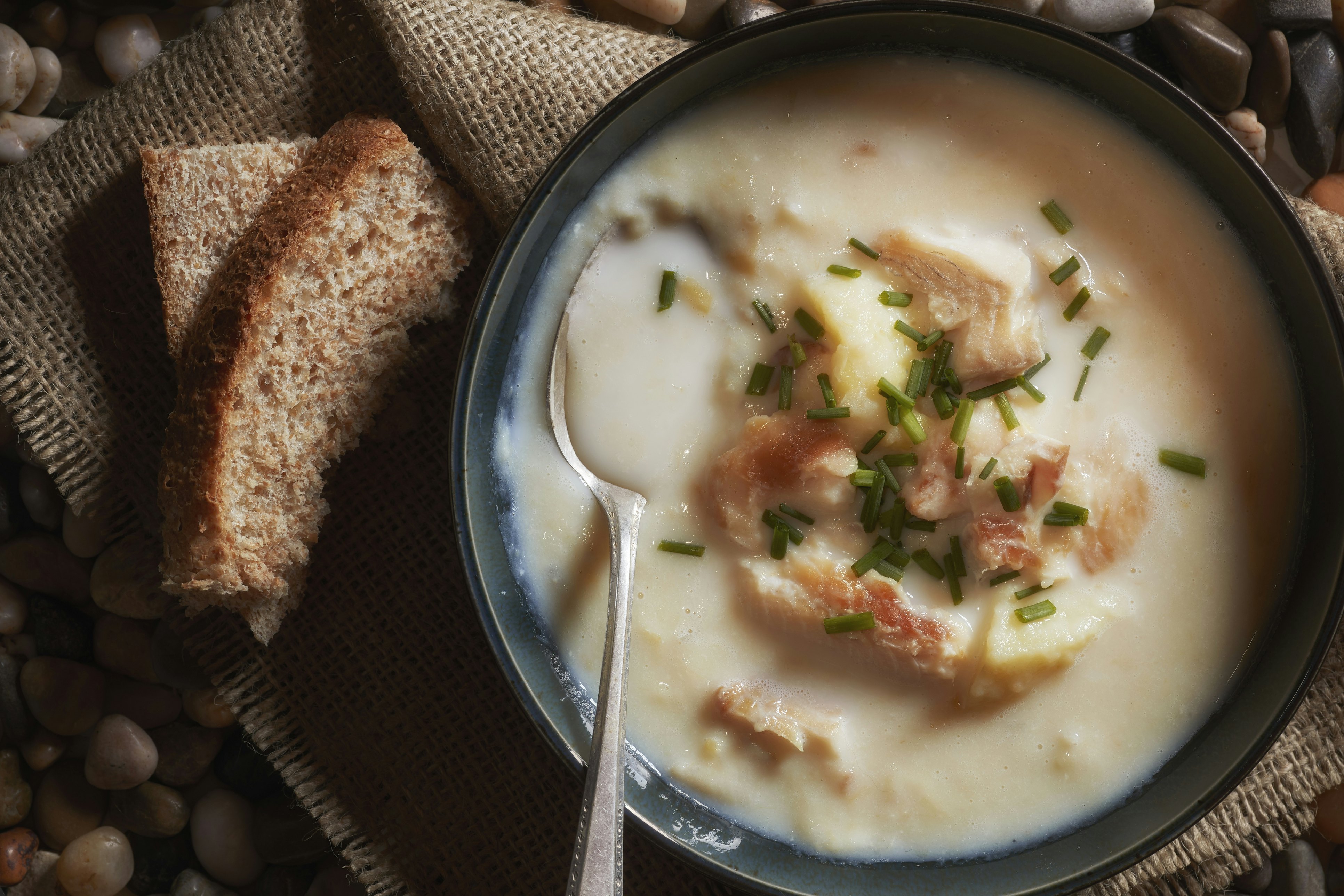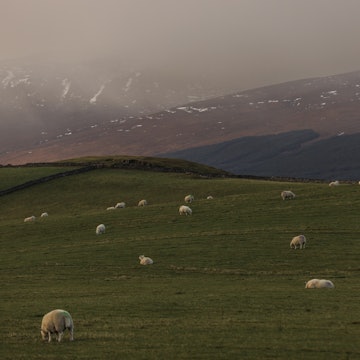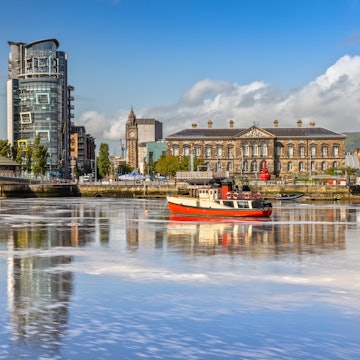

People enjoy dining in the sunny outdoors in Edinburgh, Scotland © benedek / iStockphoto/ Getty Images
Scottish food will forever be associated with the deep-fried Mars bar, but this massively undersells a rich and varied national cuisine that can match anything found in the British Isles. Predictably, big cities in Scotland offer the richest pickings for foodies, but you’ll find impressive gastronomic experiences across the country, from rural pubs and B&Bs to community cafes on outlying islands.
At its heart, Scottish cooking is about comfort food – solid, nourishing fare, sometimes high in fat and high in carbs, that will keep you warm as you hike across the Highlands or cruise from harbor to harbor in the Scottish Islands. From a porridge breakfast to a full haggis dinner with neeps (turnips or swedes) and tatties (potatoes), you’ll rarely leave the table feeling hungry in Scotland.
But that’s just part of the picture. Scottish chefs have taken a leading role in the culinary revolution sweeping across the British Isles, and you’ll find an inspiring array of local and sustainable produce on offer, including found-only-in-Scotland treats such as seaweed-fed lamb and Mull cheddar, made with milk from cows fed on fermented grains from the local whisky distillery.
Scotland's traditional drinks – whisky and beer, and increasingly, gin – are also finding a new lease of life, with single malts being fêted like fine wines and microbreweries filling the bar taps with interesting brews.
Here's a guide to the best things to eat and drink in Scotland.
Fuel up with a full Scottish breakfast
Though porridge is the most famous Scottish breakfast, few Scots start the day with a bowl of oats these days; a cappuccino and croissant are more likely. Fewer still eat porridge the traditional way, with salt instead of sugar. Nevertheless, if it’s on offer, porridge provides a nourishing, high-energy start to the day.
At B&Bs and hotels, you’re more likely to encounter the 'full Scottish' breakfast – fruit juice and cereal, toast and jam, a pot of coffee or tea, and a fry-up consisting of any or all of the following: bacon, sausage, black pudding (a type of sausage made with oatmeal, onion and pig’s blood), grilled tomato, mushrooms, potato scones and eggs. Most B&Bs offer a vegetarian version as an alternative, and some places are eliminating the fried plate entirely in favor of a healthier option such as fruit salad or kippers.
Where to try it: If you can’t get a full Scottish breakfast where you’re staying, Edinburgh’s small and friendly Fountain Cafe is reputed to serve the best Scottish fry-ups in the capital, complete with all the essentials.
Appreciate the fine flavors of smoked fish
Eating fish for breakfast might sound strange, but this was the traditional option in many crofting (smallholding) and fishing communities back in the days when seafood was the staple foodstuff. Many hotels still offer grilled kippers (smoked herrings) or smoked haddock (poached in milk and served with a poached egg) for breakfast – delicious with lots of buttered toast.
Then there’s the highly regarded Arbroath smokie – locally-caught haddock, salted and smoked over a hardwood fire. The delicacy was reputedly invented in the small fishing village of Auchmithie (three miles northeast of Arbroath) following a fire in a warehouse storing salted haddock, but it’s more likely to have been imported by Viking settlers from Scandinavia.
Popular cold-smoked products (smoked at less than 34°C) include smoked salmon, kippers and Finnan haddies (cold-smoked haddock), while hot-smoked products (smoked at more than 60°C) include bradan rost ('flaky' smoked salmon) and Arbroath smokies.
Where to try it: Scotland has many small producers of smoked fish, but the Arbroath smokies produced by Iain R Spink in Arbroath have been hailed as one of the top 50 foods in Britain. Loch Fyne is the source of some of Scotland’s best bradan rost; sample it alongside Scottish oysters at the Loch Fyne Oyster bar in Cairndow at the head of Loch Fyne.

Warm your insides with traditional Scottish soups
A steaming bowl of soup is the perfect way to thaw out after a hike through the highlands, and it’s a standard part of a pub or cafe lunch. Scotch broth, made with mutton stock, barley, lentils and peas, is nutritious and tasty, while hearty cock-a-leekie is made with chicken and leeks. Warming vegetable soups include leek and potato soup and the local variation on lentil soup, traditionally made using ham stock – vegetarians, beware!
Seek out traditional Scottish seafood soups such as the delicious Cullen skink, made with smoked haddock, potato, onion and milk, and partan bree, a nourishing rice and crab soup from the northeast coast, where Scotland’s best crabs are landed.
Where to try it: If you’re going to sample Cullen skink, try it at the source at the Rockpool in Cullen, where hearty bowls made with locally-caught fish are served as dishes by themselves or as a side with a sandwich.
Do you dare try deep-fried everything?
Okay, it’s a Scottish cliche, but fish and chip shops across Scotland do indeed serve a variety of deep-fried snacks that would send cardiologists running for the hills. Deep-fried Mars bars are just the start – you’ll also find deep-fried pizzas, deep-fried burgers in buns and deep-fried butter balls. Just stick to salad for the next few days to balance the oil intake…
Where to try it: For the full suite of deep-fried treats, try no-frills favorite The Clamshell in Edinburgh – a popular post-pub stop for battered Mars bars, pizzas and more, located just off the Royal Mile.

Feast on scrumptious Scottish seafood
Scottish seafood is some of the best in the world, and sampling the bounty of the North Sea is a highlight of a visit to the country, particularly along the west coast. There's growing awareness of the importance of sustainability, and many seafood places provide information on the provenance of their seafood.
Tucking into some hand-dived scallops and creel-caught langoustines as the sun sets over the gray-blue sea is one of Scotland’s great gastronomic pleasures. It's not all about starched napkins and claw crackers; the coast is dotted with simple seafood shacks serving up seafood that’s so fresh you can almost hear the swoosh of the nets opening on deck – and often at bargain prices.
The trout is the smaller cousin of the salmon, and rod-caught wild brown trout and farmed rainbow trout are served widely, often fried in oatmeal. Herring fillets fried in oatmeal are also good if you don't mind picking out a few bones. Mackerel pâté and smoked or peppered mackerel (both served cold) are also popular.
Alongside various kinds of bony fish, seek out juicy langoustines (also known as Dublin Bay prawns, Norway lobsters or simply 'prawns'), brown crabs, squat and European lobsters, oysters, mussels and local scallops.
You’ll also encounter fish in the form of cardiovascularly challenging portions of fish and chips, while langoustine tails pop up frequently as breaded scampi. You’ll find both served in fish and chip shops and pubs across Scotland.
Where to try it: For full-flavored fish and chips, it’s hard to beat the Bay in Stonehaven in Aberdeenshire. The owners strive to use only sustainable fish and have been recognized by the Maritime Stewardship Council, and the menu runs to haddock burgers and fishcakes. For a gourmet seafood experience that won’t break your bank account, try Fishers in Leith, serving imaginative takes on seafood classics in a 17th-century watchtower.
Slurp down lip-smacking Scottish salmon
Scottish salmon is famous worldwide, but there's a big difference between the ubiquitous farmed salmon and the leaner, more expensive wild variety (there is now only one wild salmon fishery in Scotland, and catches are carefully managed). As there are concerns over the environmental impact of salmon farms, the wild version is perhaps the more ethical option.
Smoked salmon is traditionally dressed with a squeeze of lemon juice and eaten with fresh brown bread and butter. You’ll find it served at restaurants and hotels all over Scotland; it’s a common breakfast option at higher-end places to stay (frequently in the form of salmon and eggs).
Where to try it: You won’t have to hunt around to find salmon in Scotland. Begin the salmon journey at the handsome Victorian-era Cafe Royal in Edinburgh, where you can enjoy both the cold version and roast smoked salmon.
Appreciate the complex flavors of Scottish meats
Steak aficionados will enjoy sampling a thick fillet of world-famous Aberdeen Angus beef. The beef from Highland cattle is also highly-regarded – just one of many traditional livestock species that enjoy a healthy, outdoor life in the Scottish countryside.
Venison, made from red deer, is leaner and appears on many menus, particularly at upscale pubs and country house hotels in the Highlands. Pork from Ayrshire is also celebrated, as is seaweed-fed lamb and mutton from Ronaldsay in Orkney.
You can also find an interesting variety of meat-based deli products from smaller, often organic producers, with pork, mutton and venison cropping up smoked, dried, ground into pâtés or sliced into charcuterie.
Where to try it: Overlooking the waters of Scapa Flow, The Foveran near Kirkwall in Orkney serves Ronaldsay mutton, Orkney beef and scallops and Orcadian Grimbister cheese. For a book-thick fillet of Aberdeen Angus steak, book a table at carnivore-favorite Kyloe in Edinburgh.

Top off a meal with a stomach-expanding Scottish pudding
Traditional Scottish puddings are irresistibly creamy, high-calorie concoctions. Cranachan is whipped cream flavored with whisky and mixed with toasted oatmeal and raspberries. Atholl brose – a mixture of cream, whisky and honey and flavored with oatmeal – falls somewhere between drink and dessert. For an all-out carb-fest, try clootie dumpling – a rich steamed pudding filled with currants and raisins, named for the 'cloot' (linen cloth) used for steaming.
Where to try it: As its name suggests, the Clootie Dumpling Cafe in Dunkeld is a great place to stop for clootie dumpling, shortbread, ginger cake and other sweet Scottish treats.
Brave your first portion of haggis
Scotland's national dish, haggis, is sometimes avoided by visitors because of its rather dubious-sounding ingredients. The finely chopped lungs, heart and liver of a sheep are mixed with oatmeal and onion, stuffed into a sheep's stomach and then boiled into a delicious savory pudding. Haggis is traditionally served with champit tatties (mashed potatoes) and bashed neeps (turnips, or more commonly, swede).
Although it's eaten year-round, haggis is central to the Burns Night celebrations on 25 January, honoring Scotland's national poet, Robert Burns. A piper announces the arrival of the haggis, and Burns' poem Address to a Haggis is recited to this, “Great chieftain o' the puddin’-race.” The haggis is then lanced with a dirk (dagger) to reveal the steaming offal within.
Vegetarians (and quite a few carnivores, no doubt) will be relieved to know that vegetarian haggis is available in many restaurants. Takeaways often serve deep-fried haggis with chips – a less theatrically visceral way to appreciate this Scottish delicacy.
Where to try it: Reliable spots to tempt (or challenge) your palate with proper Scottish haggis include Urquhart’s in Inverness, Wedgwood the Restaurant in Edinburgh and Glasgow’s Ubiquitous Chip.
Sink a pint of Scottish ale in a local pub
Scottish breweries produce a wide range of beers, with generic international lagers appearing alongside traditional Scottish real ales and a growing selection of craft beers from small regional breweries. Draught beer is served in pints (568mL) or half pints; alcoholic content generally ranges from 3% to 6%. What the English call bitter, Scots call ‘heavy’ or ‘export.’
Traditional Scottish ales use old-fashioned 'shilling' categories to indicate strength. The number of shillings was originally the price per barrel; the stronger the beer, the higher the price. The usual range is from 60 to 80 shillings, written “80/-” but you’ll also find stronger 90-shilling beers.
The craft beer revolution has hit Scotland full tilt. Small breweries are producing all sorts of exciting beers, from organic lagers to traditional Scottish ales, American-influenced pale ales and various dark beers. Visit the website of the Campaign for Real Ale for a comprehensive list of Scottish breweries, both large and small.
Where to try it: Many craft breweries have their own pubs, and some pubs brew a handful of their own ales on-site. Good places to taste craft beer at the source include Pitlochry's Moulin Hotel, the St Andrews Brewing Company and the Royal Dick inside Edinburgh's Summerhall.

Appreciate a dram of single malt whisky
Scotch whisky (always spelled without an 'e' – whiskey with an 'e' is Irish or American) is Scotland's best-known product and its biggest export. Prepared using malted barley and aged in oak casks for a minimum of three years, Scotch has been distilled in Scotland at least since the 15th century and probably for much longer. Every region has its own distilleries, each with a distinctive flavor profile created by the local water and the fuel used to malt the barley.
The standard measure in pubs is either 25mL or 35mL. This is often described as a dram, though the term technically refers to a measure of one-eighth of an ounce. As well as whiskies, there are whisky-based liqueurs such as sweet, sticky Drambuie. If you must mix your whisky with anything other than water, try a whisky mac (whisky with ginger wine) – after a long walk in the rain, there's nothing better for putting a warm glow in your belly.
Scottish gin also has a growing reputation – seek out the version produced by the Isle of Harris distillery, flavored with sugar kelp seaweed. In many bars and pubs, you’ll also find mixer drinks made with local spirits and Barr's Irn-Bru, a sweet, radioactive-colored fizzy pop that smells like bubblegum.
Where to try it: Every whisky aficionado has their own favorite distillery, and most offer tours with tastings. The tours run by the Glenlivet Distillery in Speyside, the charming Jura Distillery on the Isle of Jura and the futuristic Macallan Distillery in Craigellachie in Moray come highly recommended.
Vegetarians and Vegans
Scotland has the same proportion of vegetarians as the rest of the UK – around 14% of the population – and vegetarianism is now firmly in the mainstream. Even the most remote Highland pub usually has at least one vegetarian dish on the menu, and there are many dedicated vegetarian restaurants in the cities. If you get stuck, there's almost always an Italian or Indian restaurant where you can get meat-free pizza, pasta or curry.
Vegans are much better catered for than in past years, and Pitlochry is now home to the UK's first ever 100% vegan hotel, Saorsa 1875. One thing to keep in mind is that lentil soup, a seemingly vegetarian staple of Scottish pub and restaurant menus, is traditionally made with ham stock.
These days, most B&Bs offer a vegetarian fry-up option, though vegans are advised to explain to their host beforehand precisely what the term means, just in case. Top vegetarian restaurants include Glasgow’s hip, meat-substitute-oriented Flying Duck, Aberdeen’s 100% vegan Bonobo Cafe and long-established Hendersons in Edinburgh.
















